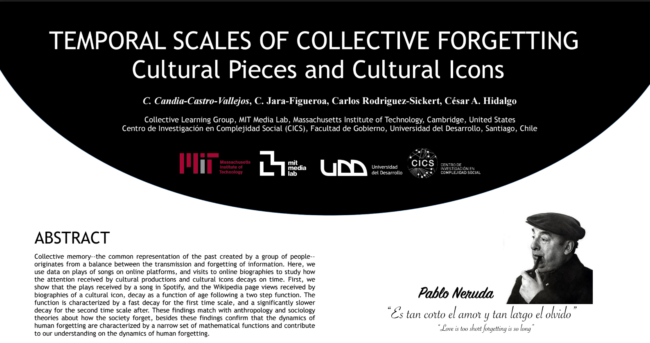[CICS on tour] “The Laws of forgetting” at International Conference on Computational Social Science
Friday, 8 September, 2017 | NEWSNot just people fall in love, social groups do too, and through this common experience songs, films and cultural icons emerge. But, as Pablo Neruda said ” Love is so short, forgetting is so long”: falling in love has an expiration date and Cristián Candia, a physical engineer and student of the Doctorate in Social Complexity Sciences (DCCS), seeks to understand and characterize the process that follows: forgetfulness.

* This note is part of the DCSS student participation register at conferences, seminars and other international events.
“I no longer love her, it’s true, but how much I loved her”
That quote is also part of Pablo Neruda’s Poem 20 and it perfectly illustrates the idea from which Cristián Candia, part of the 2014 DCCS generation, investigates the universal social phenomenon of oblivion of pieces of information.
As in the work of the chilean poet, the physical engineer starts his research once the “love” already happened, that is, when a piece of information was produced and communicated among the people to make it a common theme. That is his initial time, or zero. From that moment begins to work the “collective memory”, the representation of the past that shares a social group and that arises from a balance between the transmission of that information and its forgetfulness.
At the 3rd Annual International Conference on Computational Social Science in Cologne, Germany, he presented a poster with the progress of “The Laws of Forgetting: Temporal scales in human Collective Forgetting”. There Candia said that this process of forgetting “has a two-step effect: a rapid initial drop followed by a slower decline. At the conference there were several people working with memory. They had identified the same phenomenon, but didn’t know what was due beyond the explanation found in literature. They lacked context and a complete explanation through mathematical models, so we decided to do it ourselves”.
The DCCS’ student and the researchers Cristián Jara, César Hidalgo (both from MIT Media Lab) and Carlos Rodríguez-Sickert (CICS), developed a model that explains how the popularity of these pieces of information varies according to how old they are. To reproduce the forgetfulness pattern, they based on the concepts of communicative memory (which is transmitted through conversations) and cultural memory (which requires a physical record, like books or digital formats).
When time is closer to zero, communicative memory becomes more important, but as it increases, cultural memory becomes more important. Both indicators, they observed, decrease at different rates. With this mathematical model, Candia is preparing to attend the Conference on Complex Systems 2017 to be held in Cancun, Mexico from September 17 to 22.


